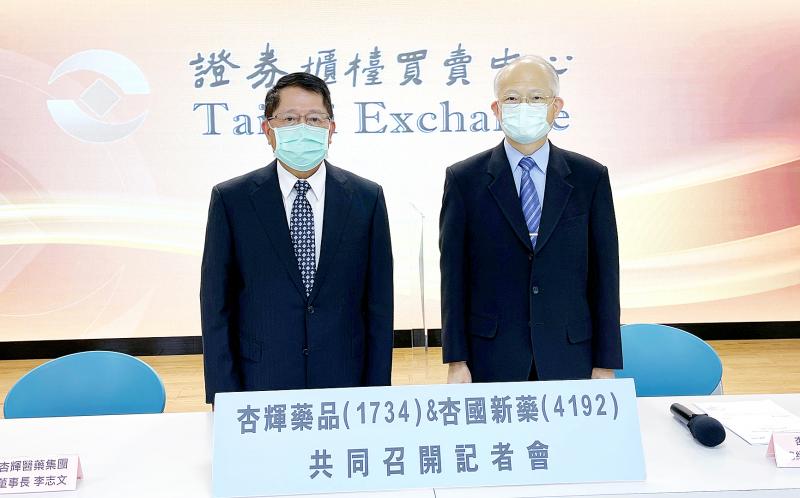The unblinding of phase 3 trial data of SynCore Biotechnology Co Ltd’s (杏國新藥) newly developed pancreatic cancer drug SB05PC showed no statistical significance when compared with the control group, the drugmaker said yesterday.
SB05PC is designed to prolong patients’ lives, and the trial ended once all participants had passed away, the company said.
The trials tested whether people taking the drug would on average live significantly longer than those in the control group, it added.

Photo: CNA
The trials tested for overall survival time — the time the patient survives from the beginning of treatment — and progression-free survival time — the time the patient’s cancer does not worsen from the beginning of treatment, it said.
The median overall survival time for the 108 participants treated with SB05PC was 226 days, while their median progression-free survival time was 113 days.
Meanwhile, the median overall survival time of the 100 patients in the control group was 209 days, while their median progression-free survival time was 110 days, the drugmaker said.
“The difference between the two groups was not statistically significant,” Tim Lee (李志文), chairman of the drugmaker’s parent company Sinphar Pharmaceutical Co Ltd (杏輝醫藥), told a news conference in Taipei.
Other secondary gauges, such as disease control rate, objective response, rate and duration of response also did not show statistical significance, the company said.
The disease control rate averaged 59.38 percent in the treatment group, compared with 48.86 percent in the control group; the objective response rate was 11.46 percent in the treatment group, compared with 6.82 percent in the control group; and response to the drug averaged 4.1 months in the treatment group, compared with 5.6 months in the control group, it said.
SB05PC was developed as a second-line treatment to be combined with chemotherapy drug gemcitabine for patients who do not respond well to first-line drug Folfirinox, SynCore said.
Trail participants either received SB05PC in combination with gemcitabine, or only gemcitabine in the control group, it said.
Although no statistical significance, which would allow SynCore to seek approval for the treatment, was found, the trials were meaningful, as it would base the further development of SB05PC on the results, Lee said.
Phase 3 trials were conducted in seven countries — Taiwan, the US, France, Hungary, Israel, Russia and South Korea — and some populations seemed to react better to the drug, Lee said.
“It was a valuable experience, and we also learned how to be more exact in deciding the development direction of a new drug. This experience is an intangible asset,” Lee said.
SynCore has been developing SB05PC for six years, investing NT$2 billion (US$71.65 million) in the treatment, Lee said, adding that Sinphar funded the project with NT$1.77 billion.
After ending the project, Sinphar is expected to regain profitability, Lee said, aiming to post annual net profit of about NT$400 million.
SynCore reported a net loss of NT$159 million for the first six months of this year, while Sinphar reported net profit of NT$10.34 million, down 71 percent from a year earlier, Sinphar data showed.

CHIP RACE: Three years of overbroad export controls drove foreign competitors to pursue their own AI chips, and ‘cost US taxpayers billions of dollars,’ Nvidia said China has figured out the US strategy for allowing it to buy Nvidia Corp’s H200s and is rejecting the artificial intelligence (AI) chip in favor of domestically developed semiconductors, White House AI adviser David Sacks said, citing news reports. US President Donald Trump on Monday said that he would allow shipments of Nvidia’s H200 chips to China, part of an administration effort backed by Sacks to challenge Chinese tech champions such as Huawei Technologies Co (華為) by bringing US competition to their home market. On Friday, Sacks signaled that he was uncertain about whether that approach would work. “They’re rejecting our chips,” Sacks

Taiwan’s long-term economic competitiveness will hinge not only on national champions like Taiwan Semiconductor Manufacturing Co. (TSMC, 台積電) but also on the widespread adoption of artificial intelligence (AI) and other emerging technologies, a US-based scholar has said. At a lecture in Taipei on Tuesday, Jeffrey Ding, assistant professor of political science at the George Washington University and author of "Technology and the Rise of Great Powers," argued that historical experience shows that general-purpose technologies (GPTs) — such as electricity, computers and now AI — shape long-term economic advantages through their diffusion across the broader economy. "What really matters is not who pioneers

BUBBLE? Only a handful of companies are seeing rapid revenue growth and higher valuations, and it is not enough to call the AI trend a transformation, an analyst said Artificial intelligence (AI) is entering a more challenging phase next year as companies move beyond experimentation and begin demanding clear financial returns from a technology that has delivered big gains to only a small group of early adopters, PricewaterhouseCoopers (PwC) Taiwan said yesterday. Most organizations have been able to justify AI investments through cost recovery or modest efficiency gains, but few have achieved meaningful revenue growth or long-term competitive advantage, the consultancy said in its 2026 AI Business Predictions report. This growing performance gap is forcing executives to reconsider how AI is deployed across their organizations, it said. “Many companies

TAIWAN VALUE CHAIN: Foxtron is to fully own Luxgen following the transaction and it plans to launch a new electric model, the Foxtron Bria, in Taiwan next year Yulon Motor Co (裕隆汽車) yesterday said that its board of directors approved the disposal of its electric vehicle (EV) unit, Luxgen Motor Co (納智捷汽車), to Foxtron Vehicle Technologies Co (鴻華先進) for NT$787.6 million (US$24.98 million). Foxtron, a half-half joint venture between Yulon affiliate Hua-Chuang Automobile Information Technical Center Co (華創車電) and Hon Hai Precision Industry Co (鴻海精密), expects to wrap up the deal in the first quarter of next year. Foxtron would fully own Luxgen following the transaction, including five car distributing companies, outlets and all employees. The deal is subject to the approval of the Fair Trade Commission, Foxtron said. “Foxtron will be